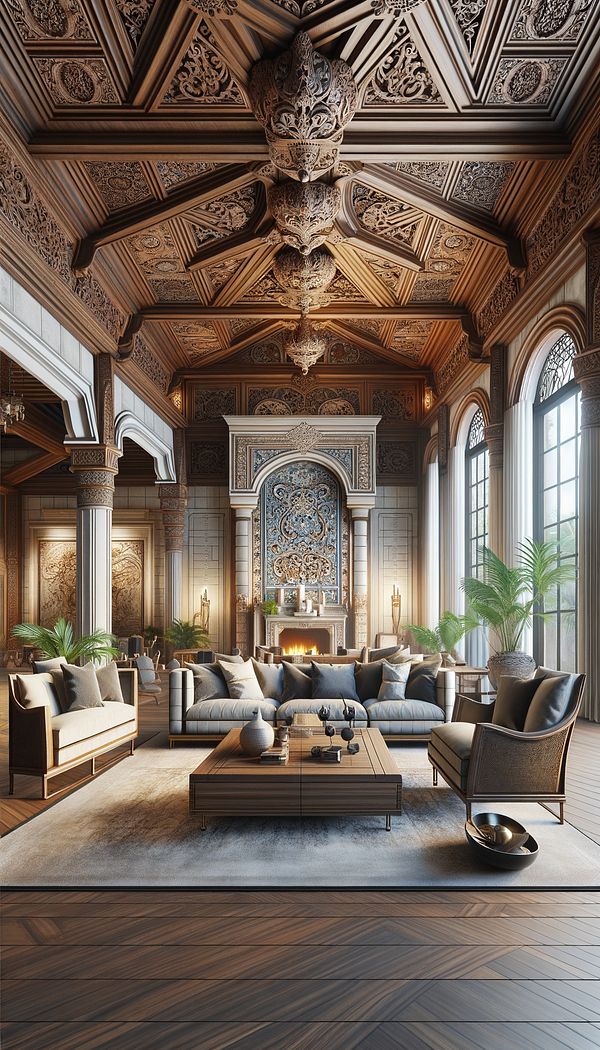What is Spanish Renaissance?
Spanish Renaissance refers to a period and style in interior design characterized by ornate decorations, rich colors, and intricate details.
Description
The Spanish Renaissance, occurring predominantly during the 15th and 16th centuries, marks a period in which Spanish interior design and architecture were heavily influenced by classical ideals. This era in Spain mirrored the broader European Renaissance, which saw a revival of Classical arts, literature, and learning, marking a departure from the medieval period's more utilitarian focus.
In terms of interior design, the Spanish Renaissance is characterized by its richness and opulence. Rooms designed in this style often feature high ceilings, intricate wooden carvings, and elaborate frescoes. Decorative elements draw heavily on classical and Gothic influences, blending them with the unique cultural elements of Spain. Notably, the use of azulejos (painted ceramic tiles), wrought iron, and wooden coffered ceilings typify this period's interior design.
Furniture during the Spanish Renaissance was robust and ornate, with heavy use of dark woods adorned with intricate carvings or inlays of ivory, metal, or other materials. Textiles were luxurious and often featured embroidery or tapestries, showcasing both local and imported fabrics.
Overall, the Spanish Renaissance created spaces that were not only grandiose but also highly decorative, reflecting a period of extensive cultural and artistic development in Spain. The period’s impact on interior design is still celebrated today for its contribution to creating dramatic, detailed, and deeply historical spaces.
Usage
Spanish Renaissance design is often implemented in spaces that aim to evoke a sense of history and grandeur. This might include historic hotels, restaurants, luxury homes, and public buildings wishing to reflect a connection to Spanish heritage and architectural tradition. The design style is not limited to historic renovations or reconstructions; contemporary designers also incorporate elements of Spanish Renaissance design into modern spaces for a timeless and elegant appeal.
FAQs
-
How do Spanish Renaissance interiors differ from other Renaissance styles?
Spanish Renaissance interiors are distinct in their use of local materials like azulejos and wrought iron, and they blend classical, Gothic, and Moorish influences unique to Spain's historical and cultural context. Compared to the lighter, more mathematically precise qualities of the Italian Renaissance, the Spanish style is often seen as more ornate and robust.
-
What are some key decorative elements in Spanish Renaissance design?
Key decorative elements include ornate wooden carvings, frescoes, azulejos (painted ceramic tiles), wrought iron details, coffered ceilings, and luxurious textiles featuring embroidery or tapestries.
-
Can Spanish Renaissance design be incorporated into modern interiors?
Absolutely. While Spanish Renaissance design is deeply historical, its elements can be selectively incorporated into modern interiors to add elegance, character, and a sense of timelessness. This might involve using azulejos in a contemporary kitchen backsplash or incorporating ornate wooden furniture pieces into a modern living space.
Practical Application
To incorporate Spanish Renaissance design into modern interiors, start by introducing elements that nod to the era without overwhelming the space. Consider using ornate wooden furniture with intricate carvings, hanging tapestries or incorporating azulejos as accent pieces. Lighting fixtures made of wrought iron and decorative textiles can also help infuse a space with the warmth and opulence characteristic of the Spanish Renaissance period. Remember, the goal is to achieve balance and harmony between historical elegance and contemporary living.
-
Architectural Elements199 articles
-
Design Styles478 articles
-
Furniture Types599 articles
-
Decorative Objects240 articles
-
Materials & Textiles360 articles
-
CrestingCresting is a decorative motif often featuring a series of repetitive shapes or forms.
-
StainingStaining is the application of pigment to a surface to change its color and enhance its grain.
-
CuratedCurated in interior design refers to a carefully selected and arranged collection of items that enhance the aesthetic and functional aspects of a space.
-
AmoriniAmorini are decorative motifs featuring cherubic children, often depicted with wings.
-
French PolishingFrench Polishing is a wood finishing technique that produces a very high gloss surface.
